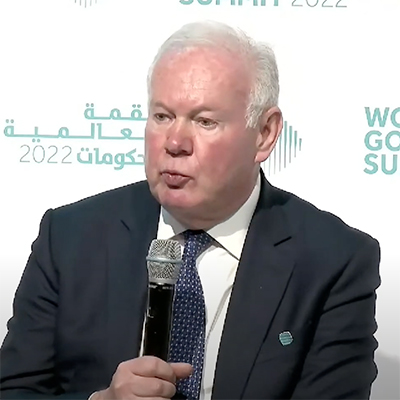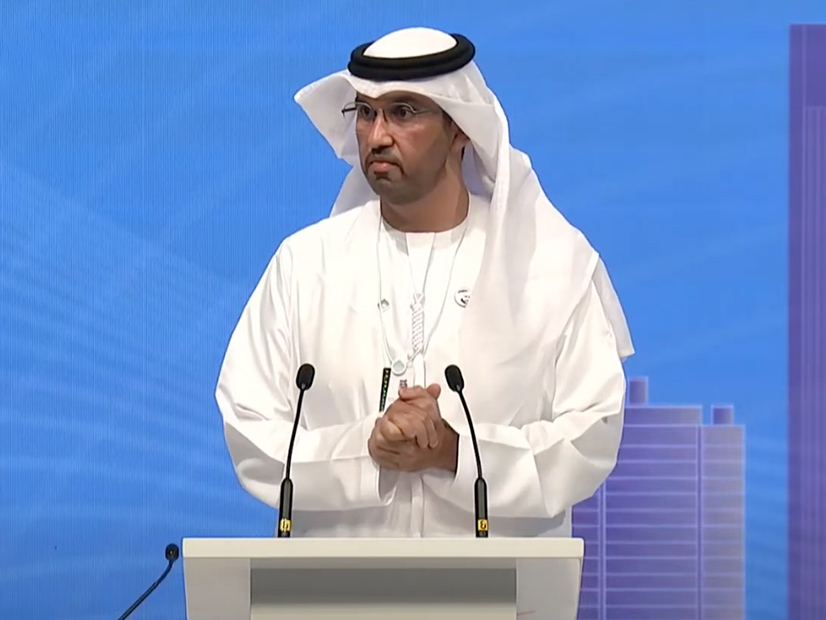The need for energy security in the wake of the war in Ukraine dominated the Atlantic Council’s 6th annual Global Energy Forum this week in Abu Dhabi as much as the threat of climate change.
Co-sponsored by the United Arab Emirates, the two-day conference drew more than 100 speakers, including energy analysts and venture capitalists from around the world, executives with gas turbine manufacturers, pipeline companies, oil and gas producers, hydrogen startups and government representatives.
European dependence on Russian hydrocarbons and the U.S. pledge to have more LNG shipped to Europe added urgency to the discussions about how to begin moving away from conventional oil and gas to renewables. Hydrogen was discussed as a fuel to augment rather than quickly replace fossil fuels.
Amos Hochstein, the U.S. State Department’s presidential coordinator, said Europe had begun this winter with low natural gas inventories because Russian state-owned Gazprom had reduced the amount of gas it exported for months before Russia invaded Ukraine. The Biden administration has announced at least 15 Bcf of additional LNG will be shipped to Europe this year, he said.
“We were able to work with market participants — U.S. companies, traders and buyers around the world — [to] redirect cargos … to Europe,” he said.
“You can’t magically bring on LNG infrastructure; you need to work with the system that you have,” he said. “There are some LNG export plants around the world that are not operating at full capacity. We are working to bring them into full capacity by increasing production on a temporary basis in those countries.”
Without saying so explicitly, Hochstein made it clear that more U.S. gas production will be needed, a development certain to infuriate environmentalists but encourage the industry, which has been reluctant to increase production because of past debt created by overproduction that drove down prices.
The price of gas contracts traded on the New York Mercantile Exchange for April closed Tuesday at $5.34/MMBTU. That was up from the March wholesale contract price of $4.57. Future monthly gas contracts through November trading on the New York Mercantile Exchange closed Wednesday in a range from $5.57 in May to $5.73 for November — an early warning for gas turbine plants and next winter’s heating bills.
“Europe is making some commitments that they will work with member states to ensure that there are long-term and contractual arrangements with U.S. infrastructure to allow for those facilities to be financed so that additional LNG can come on the market sooner,” Hochstein explained. “We are living in this strange world of energy transition, where we have to make sure that we have enough supplies of oil and gas today and over the next several years as we accelerate and double down on the energy transition itself, whether it’s through expansion of nuclear and including small modular reactors [SMRs] as well as other renewables and … clean energy technology that will reduce demand.”
Reducing demand for natural gas is a second leg of the strategy, Hochstein said. Even before the Ukrainian war, Europe had begun to diversify its energy sources, he said.
“There’s no doubt that is going to take time though. It’s not going to happen this year. And even by the end of the decade, we’re not going to see the biggest declines in demand. We have to plan for the short term, the medium term and the long term.
“We are looking to get away from the reliance on fossil fuels,” he added. “In the short term, we need to make sure that our system and our economy is well supplied to be able to sustain growth and to avoid the kind of inflationary actions that we’re seeing today in the market.
“But one thing is for sure, this war has totally and completely changed the narrative and how we view Russian supplies into Europe and the critical need to diversify away from Russian supplies into the future.
“That is a tall order, but it has to be done, and I don’t think there is more than one or maybe two countries in Europe that don’t fully understand this issue and commit themselves to this.”
Trillions of Dollars to Decarbonize
Kara Mangone, director of climate strategy at Goldman Sachs said the firm estimates that funding the transition to renewables envisioned by the 2015 Paris Agreement will require $3 trillion to $5 trillion a year or $100 trillion to $150 trillion total.
“We’re nowhere near that today. About half of that capital will need to go into renewables and technologies that are at commercial scale today; but the other half, very importantly, will need to go into carbon capture; into hydrogen; into direct air capture; into sustainable aviation fuel and e-fuels.
“These are the fuels technologies that are not yet being adopted on a commercial scale because they have not hit the price point where that can happen for a lot of companies.”
Estimating that global business and industry is currently investing about a third of what Goldman thinks must be spent, Mangone said the new technologies should not be financed by pulling funding from traditional technologies. To remain commercially viable, industry “cannot pull out financing from the exact sectors: the oil and gas sector, metals and mining, real estate [and] agriculture,” she said.
Andre Pienaar, founder and CEO of C5, a venture capitalist company, said legacy nuclear is one of those older technologies that must be supported and that firms such as his should be investing in companies building SMRs.
Calling SMRs a “complete sea change,” Pienaar said advanced nuclear “has a very important contribution to make, to provide a secure and always-on source of fossil-free energy for the future to enable us to reach these goals.”
In an earlier event initiating the forum, Sultan Al Jaber, CEO of Abu Dhabi National Oil Co. and special envoy for climate change, also stressed that the transition to renewables and carbon-free synthetic fuels cannot happen overnight with little regard to existing technologies.
“Ladies and gentlemen, the theme for this year’s forum, the geopolitics of the energy transition, could not be more timely. We are all witnessing firsthand how sensitive energy markets are to geopolitical shocks,” Jaber said in opening remarks.
“The current volatility in oil prices is the result of a deeper underlying structural issue. Long-term underinvestment in oil and gas has left markets more exposed to risks of any kind, and wherever they take place.
“According to the [International Energy Agency], investment in oil and gas is $200 billion below where it needs to be. And that is just to keep up with demand through 2030. Near term, we’re also seeing markets tighten with demand up almost 3 million barrels over last year and expected to reach pre-pandemic levels by fourth quarter of this year.
“In short, the push to divest from hydrocarbons has met a stark reality, and we must accept and acknowledge that when we fully embrace the energy transition, we need to recognize that policies should be tailored to real-world scenarios.
“And they should follow the basic rule of progress: that if we fail to plan, our plan will definitely fail. Put simply, we cannot and must not unplug the current energy system before we have built the new one,” Jabar argued.
The Role of Hydrogen
Whether produced from natural gas or with renewable energy, or converted to a liquid such as ammonia or methanol, or shipped globally or moved through pipelines, hydrogen’s future role repeatedly emerged as a way to deal with climate concerns and at the same time address national energy security. (See Global Hydrogen Conference Reveals Plans to Ship Sunshine.)
 Roger Martella, GE | Atlantic Council
Roger Martella, GE | Atlantic Council
Hydrogen made from natural gas was also seen as a crucial and immediately available decarbonization tool, initially as a fuel for gas turbine power plants. The Biden administration has allocated $8 billion to help industry create at least four “hydrogen hubs,” two of which would be in regions rich in natural gas.
Roger Martella, chief sustainability officer for General Electric, said using hydrogen as a generation fuel for gas turbines just makes sense.
“We think of hydrogen as a breakthrough technology. And it is because it’s not really commercially feasible today. It’s something we’re investing in around the corner. But it’s also a unique breakthrough technology because it is, I’d say, technologically proven. We can run our turbines today on hydrogen. One hundred turbines have run for more than 8 million hours on hydrogen. Whether it’s blue hydrogen or green hydrogen, the technology exists to create it. We need to focus on the commercial feasibility of it,” he said.
“Our attitude is that all hydrogen is good hydrogen at this point. And what we’re hearing about infrastructure is key. Power generation seems to be the obvious [first] go-to place because it makes sense. We can run our turbines on hydrogen today; we can create power, and that’s an immediate decarbonization benefit,” he added.
 Snam CEO Marco Alverà | Atlantic Council
Snam CEO Marco Alverà | Atlantic Council
Marco Alverà, CEO of Snam, Europe’s largest pipeline company, said 99% of the company’s pipeline system can move hydrogen today, but the company will start with blends until the demand for hydrogen develops. Snam plans to move hydrogen produced by renewable energy in northern Africa throughout Europe.
“The blending of methane and hydrogen is a good way to create the market, to create immediate demand, like we did for biofuels in Europe,” Alverà said.
Though he did not mention regulators, moving pure hydrogen in pipelines is not currently permitted in Europe but regulators will have to address the issue because pipelines are the least-cost way of moving gas.
“The cheapest way to move any gas is via pipe,” he added, possibly in a reference to plans by Canadian, Japanese and Australian companies and at least one U.S. hydrogen startup to convert hydrogen into liquid ammonia, methanol or a similar liquid chemical and ship it in ocean-going tankers to Europe, Japan and South Korea.
This will take years and trillions of dollars of investment.
“It’s the same with natural gas, and it will be the same with hydrogen,” Alverà said of the slow transition. “There will be different uses for hydrogen, whether it goes into a synthetic fuel like diesel, whether it goes into ammonia, whether it goes into methanol.
“Where it has to replace coal and natural gas for baseload energy in industry, it will be impossible to beat the cost competitiveness of pipelines,” he said.
Regina Mayor, head of energy and natural resources at the global accounting firm KPMG, warned that investment in innovative technologies will be constrained until accounting firms can figure out how to count carbon emissions emitted by current fuels.
She said a surprising number of energy investment analysts “don’t even understand that the basic carbon reporting that we see today [is] based on algorithms, measurements, extrapolations.
“The accounting firms really have to figure out how we [can] start counting carbon emissions in the same way that we count currency down to detailed levels. And only then I think, will we have the level of transparency to reduce emissions that we need to [in order for] the investor community to be confident in what we’re doing,” she said.
 Charles Hendry, former UK energy minister | Atlantic Council
Charles Hendry, former UK energy minister | Atlantic Council
That lack of detail puts corporations pressured by investor activists in a quandary, said Charles Hendry, former U.K. energy minister.
“I think investors are becoming much more critical in this area. If you look at the way that they’ve turned their backs on coal, it is very hard to find public investment into coal now. And oil and gas run the risk of moving in the same direction,” he said. “And publicly quoted [traded] companies, they have got to face shareholder activism.
“And if they are not moving in the right direction, if they are not investing heavily in low-carbon technologies in the way that BP and Shell are, if they’re not tackling their methane emissions, if they’re not looking at how they advance carbon capture, they will then be marked down and will find it much more difficult to get there,” he said.

